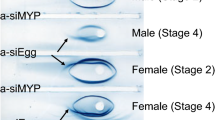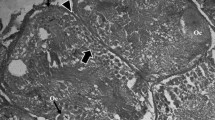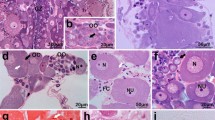Summary
A high-molecular-weight glycoprotein with a sedimentation coefficient of 22.6 has been isolated and characterized from the accessory cells in the previtellogenic ovary of the echinoid Dendraster excentricus. This glycoprotein is similar to the major yolk glycoprotein of the mature egg in its electrophoretic mobility under non-denaturing conditions, high mannose-type glycan, amino acid composition, constitutive glycopeptides, and immunological determinants. Previous histological and electron microscopical analyses led to the hypothesis that vitellogenesis involves a translocation of material from the accessory cell in the ovary to the oocyte. Because of the close similarities of the accessory cell glycoprotein to the yolk glycoprotein of the mature egg, we conclude that the glycoprotein in the accessory cell is a precursor to the major glycoprotein of the egg yolk. This conclusion is further supported by our additional finding that the accessory cell of another echinoid, Strongylocentrotus purpuratus, also contains a high-molecular-weight (24 S) glycoprotein which shows similarities to the yolk glycoprotein of the mature egg in the carbohydrate moiety and the constitutive glycopeptides.
Similar content being viewed by others
References
Amenta JS (1964) A rapid chemical method for quantification of lipids separated by thin-layer chromatography. J Lipid Res 5:270–272
Bligh EG, Dyer WJ (1959) A rapid method of total lipid extraction and purification. Can J Biochem Physiol 37:911–917
Chatlynne LG (1969) A histochemical study of oogenesis in the sea urchin Strongylocentrotus purpuratus. Biol Bull 136:167–184
Cowden RR (1962) RNA and yolk synthesis in growing oocytes of the sea urchin Lytechinus variegatus. Exp Cell Res 28:600–604
Fry BJ, Gross PR (1970) Patterns and rates of protein synthesis in sea urchin embryos. II. The calculation of absolute rates. Dev Biol 21:125–146
Fuji A (1960) Studies on the biology of the sea urchin. I. Superficial and histological gonadal changes in gametogenic process of two sea urchins, Strongylocentrotus nudus and S. intermedius. Bull Fac Fish Hokkaido Univ 11:1–14
Geary ED (1978) Oogenesis in the Pacific sand dollar Dendraster excentricus (Eschscholtz). MS Thesis, University of Alberta
Giese AC, Greenfield L, Huang H, Farmanfarmaian A, Boolootian R, Lasker R (1958) Organic productivity in the reproductive cycle of the purple sea urchin. Biol Bull 116:49–58
Goldschmidt-Vasen RM (1967) Protein content of sea urchin embryos, fractions, and particles. MS Thesis, Massachusetts Institute of Technology
Harrington FE, Easton DP (1982) A putative precursor to the major yolk protein of the sea urchin. Dev Biol 94:505–508
Holland ND, Giese AC (1965) An autoradiographic investigation of the gonads of the purple sea urchin (Strongylocentrotus purpuratus). Biol Bull 128:241–258
Ii I, Deguchi K, Kawashima S, Endo S, Ueta N (1978) Water-soluble lipoproteins from yolk granules in sea urchin eggs. I. Isolation and general properties. J Biochem [Tokyo] 84:737–749
Infante AA, Nemer M (1968) Heterogeneous ribonucleoprotein particles in the cytoplasm of sea urchin embryos. J Mol Biol 32:543–565
Kondo H, Koshihara H (1972) Immunological studies on the 26 S particles of sea urchin eggs. Exp Cell Res 75:385–396
Kraeger SJ, Hamilton JG (1969) Quantitative glass-paper chromatography of fungal cell wall acid hydrolysates. J Chromatogr 41:113–115
Laemmli UK (1970) Cleavage of structural protein during the assembly of the head of bacteriophage T4. Nature 227:680–685
Liebman E (1947) The trephocytes and their functions. Experientia 3:442–451
Lowry OH, Rosebrough NJ, Farr AL, Randall RJ (1951) Protein measurement with the Folin phenol reagent. J Biol Chem 193:265–275
Malkin LI, Mangan J, Gross PR (1965) A crystalline protein of high molecular weight from cytoplasmic granules in sea urchin eggs and embryos. Dev Biol 12:520–542
Miki-Nomura T (1968) Purification of the mitotic apparatus protein of sea urchin eggs. Exp Cell Res 50:54–64
Miller RA, Smith HB (1931) Observations on the formation of the egg of Echinometra lucunter. Carnegie Inst Wash Publ 413:47–52
ORTEC (1970) Application note 32: Techniques for high resolution electrophoresis. Oak Ridge
Ozaki H (1980) Yolk proteins of the sand dollar Dendraster excentricus. Dev Growth Differ 22:365–372
Ozaki H (1982) Vitellogenesis in the sand dollar Dendraster excentricus. Cell Differ 11, 315–317
Ozaki H (1985) A developmental program of cell surface change in the sea urchin egg. Dev Growth Differ 27:180
Pearse AGE (1968) Histochemistry-theoretical and applied, 3rd edn, vol 1. J. & A. Churchill Ltd, London
Schmidt G, Thannhauser SJ (1945) A method for the determination of desoxyribonucleic acid, ribonucleic acid, and phosphoproteins in animal tissues. J Biol Chem 161:83–89
Schneider WC (1945) Phosphorous compounds in animal tissues. I. Extraction and estimation of desoxypentose nucleic acid and of pentose nucleic acid. J Biol Chem 161:293–303
Schuel H, Wilson WL, Wilson JR, Bressler RS (1975) Heterogeneous distribution of “lysosomal” hydrolases in yolk platelets isolated from unfertilized sea urchin eggs by zonal centrifugation. Dev Biol 46:404–412
Shimomura O, Johnson FH (1969) Properties of the bioluminescent protein aequorin. Biochemistry 8:3991–3997
Spiro RG (1966) Analysis of sugars found in glycoproteins. Methods Enzymol 8:3–26
Takashima R, Takashima Y (1965) Studies on the submicroscopical structures of the nurse cells in sea urchin ovary with special reference to the glycogen particles. Okajimas Folia Anat Jpn 40:819–831
Takashima Y, Takashima R (1966) Electron microscope investigations on the modes of yolk and pigment formation in the sea urchin oocytes. Okajimas Folia Anat Jpn 42:249–264
Tsukahara J, Sugiyama M (1969) Ultrastructural changes in the surface of the oocyte during oogenesis of the sea urchin Hemicentrotus pulcherrimus. Embryologia 10:343–355
Verhey CA, Moyer FH (1967) The role of accessory cells in sea urchin oogenesis. Am Zool 7:754
Wieme RJ (1965) Agar gel electrophoresis. Elsevier Publishing Co., Amsterdam
Williams CA, Chase MW (eds) (1971) Precipitation analysis by diffusion in gels. Methods Immunol Immunochem 3:101–374
Author information
Authors and Affiliations
Rights and permissions
About this article
Cite this article
Ozaki, H., Moriya, O. & Harrington, F.E. A glycoprotein in the accessory cell of the echinoid ovary and its role in vitellogenesis. Roux's Arch Dev Biol 195, 74–79 (1986). https://doi.org/10.1007/BF00444043
Received:
Accepted:
Issue Date:
DOI: https://doi.org/10.1007/BF00444043




